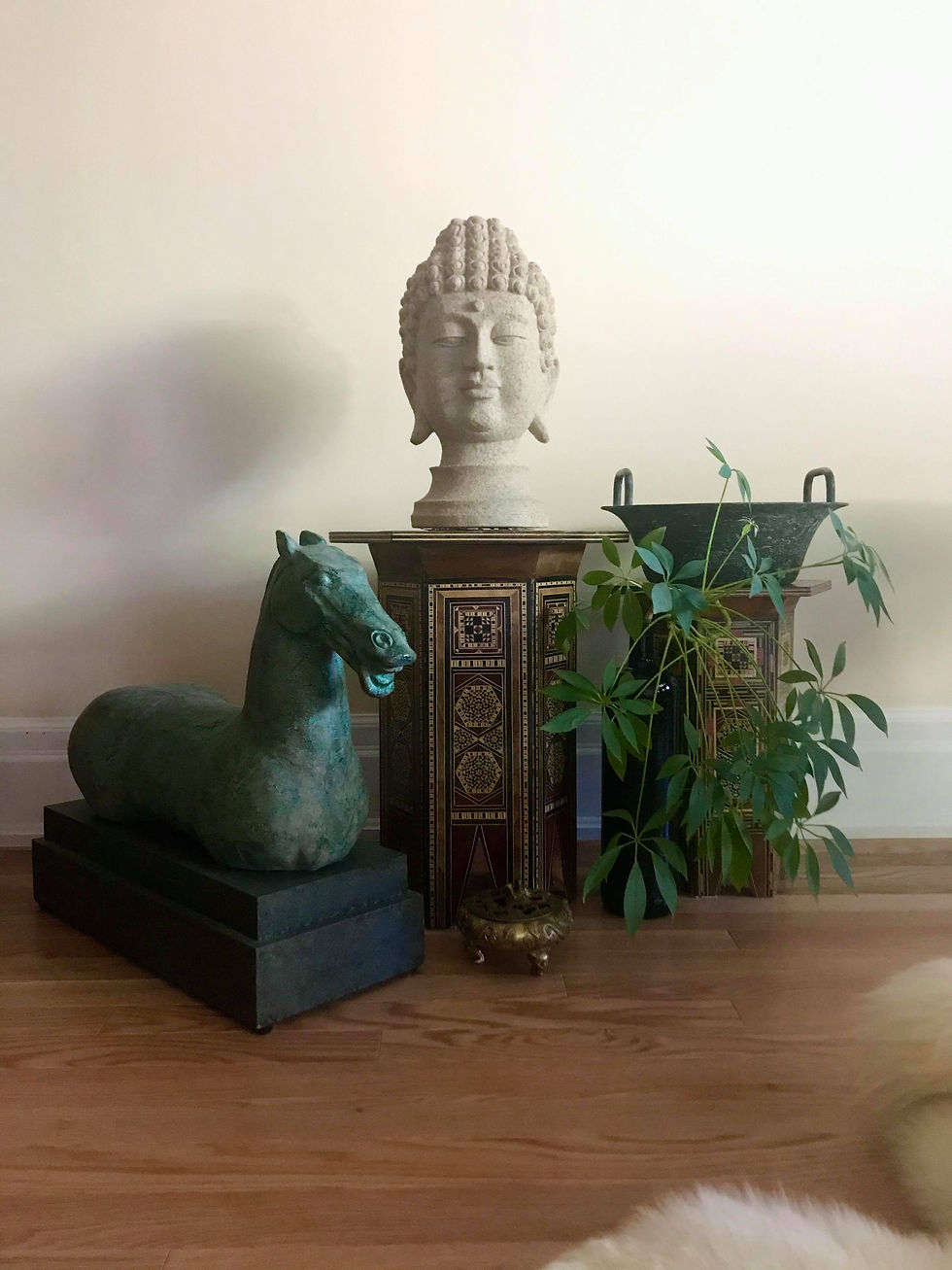Through three generations of women, a deep love of caring for plants was born.
Famed by Marco Polo for being the Venice of Asia, Suzhou is a Chinese city in Jiangsu Province with incredible traditional gardens and meticulously preserved bonsai collections. Spliced between the extreme modernisation lies multi-century-old homes and courtyards that whisper ancient stories of grandeur that detail China’s rich history. In the spring, bamboo shoots grow in home backyards and along pathways ready to be plucked, prepared, and eaten. Within this environment, my grandmother can probably be found sitting in her gazebo next to a canal and staring at her ancient plum bonsai trees. As a young child, my mother and grandmother would take me to the Flower and Bird Market (花鸟市场) in Suzhou. This was a traditional street market where individual sellers would showcase their rare orchids, carnivorous plants, handmade pottery, exotic insects, and thousands of plants of every shape and type. My mother would let me spend hours picking pots and succulents so that I could make arrangements and plant them for my grandmother's courtyard garden.
Thus, my journey with plants began, having been passed down from my grandmother to my mother, to me. Even on the opposite end of the planet in a decidedly non-tropical Canadian environment, for as long as I can remember, there has always been greenery in my home. Where my grandmother and I both inherited a green thumb, it seemed as though the ability to grow plants from nothing skipped my mother’s genes. My childhood memories are splashed with memories of my mother bringing home fantastic tropical plants only for them to mysteriously disappear. As a small child, I thought nothing of it, but looking back, we all laugh from stories of root rot and plants suddenly being chopped in half only to be stuck in wine bottles to grow hydroponically forever.

As I got older, I started taking care of our family plants more and quickly realised that I had a knack for enabling them to thrive. But, that isn't where things took a turn into junglemania.
In 2016, I was in a near-fatal accident that negatively impacted my autoimmune disorder and left me with a diagnosis of PTSD. Life changed drastically. It was the start of my university career and I was going into unknown territory. Then, as a byproduct of the accident, another condition steadily started worsening and I was having the worst rheumatoid arthritis attack of my life. Suddenly, not only did I have to deal with a fragile new state of mind, but I found myself needing to be retaught how to hold a pencil and write. The most basic tasks that I had always taken for granted were now challenges to the highest degree that I needed to overcome.

I am very fortunate to have had such an amazing network of family and friends that have helped me every step of the way. In 2017, I welcomed my service dog, Onyx, and my first air plant, a Tillandsia ionantha. I started taking care of all our family plants with renewed vigour and soon needed to challenge myself with high-maintenance, fussy, tropical plants. This led me down the rabbit hole of discovery for uncommon and rare tropicals until one day, my father woke up and walked downstairs only to declare that the house was starting to look like we were losing at a game of Jumanji.
The quest for finding rare plants opened up a wealth of opportunities and community support where I found enthusiastic plant collectors across the world. New treasure hunting adventures started with road trip quests to find rare plants and a stint at an incredibly busy Christmas Exotic Plant convention. Here, crowds lined up for hours before the opening in the hopes of being able to purchase Monstera Thai Constellations, Alocasia Black Velvets, and Philodendron Ring of Fires.
More rewarding than giving loving homes to hundreds of living organisms is the ability to share this love of plants with family, friends, and community. There's something really special in cloning a plant, nurturing it until it becomes strong, then gifting it to someone new. It is the culmination of giving someone a piece of your love and passion. It is perhaps one of the best gifts, one that stays for years to come, and one that teaches the recipient patience, acceptance, and attention to detail. Sometimes, no matter how much love you give to a plant, it does not survive. Instead of feeling guilty and calling oneself a plant murderer, it is better to treat it as a learning opportunity. Focus on analysis, troubleshoot dangers like pest problems, fungal infections, and root rot. At the end of the day, it prepares you for living life in the present. Everything has a life span and regardless of the circumstances, you cannot always bring something back from the brink of death.
Then again, just as my own life proves, sometimes you are fortunate enough to get a second chance at living and you sprout back up from the ashes. Many plant lovers would agree that this is the most magical feeling in the world.
What makes a plant special? To me, the answer to this question isn’t answered by rarity and collector’s appeal alone. I like the whimsical and weird, the strikingly beautiful, and the grotesque. Although I love to look at trendy plants, I don’t collect them for social media likes and views. I simply collect the plants that make me feel happy. Within my own collection, sometimes the most special plants are not the rarest or most colourful, but rather the ones that are from the people I care about the most. Of course, there are also some uncommon and rare plants that mean a lot to me as well. My first two uncommon and rare collector milestone plants are among my most special.
My first uncommon plant was the elusive Pink Princess Philodendron. At the time, she was quite rare and people would often pay hundreds of dollars for them at auction. I had heard of a lead for one such baby specimen being sold at a private collector a fair drive away from Toronto. Not wanting to go to a stranger's house alone for the potentially scary purchase of an exotic aroid, I called up my good friend and we managed to securely purchase this tiny black leafed vine with a few splashes of pink. However, life is ephemeral and some lives live longer than others. I'd like to think that even though I will never see this friend again, this little Pink Princess Philodendron will keep their memory alive even long after I have turned back into ashes.
My first rare plant was a jewel Alocasia, the Silver Dragon. My father gave me this wishlist plant as a birthday gift. However, the plant hadn't acclimatised much to the Canadian winter and it must have been a crazy shock for it to suddenly wake up in our house instead of the tropical Indonesian greenhouse where it was grown. Within two weeks, most of her leaves were dead and gone. Today, almost 4 months later, her newest leaf has unfurled. Not only is she beautiful, but she reminds me every day to continue to find a way to adapt and thrive in the worst of environmental shifts.
This leads me to today. As it has been ingrained into our minds incessantly over the past few months, we are living in unprecedented times. Seemingly overnight, our daily lives have been uprooted and we are left to grow in foreign new climates. In December, I accepted the Cansbridge Fellowship Program and expected to be spending my summer of 2020 working at a research lab for medical AI at the University of Tokyo. In February, I accepted an undergraduate research award from the National Sciences and Engineering Research Council of Canada (NSERC) for this summer and differed my Cansbridge experience for summer 2021. I never would have expected that by March, my university shut down and much of the planet went into lock-down. My NSERC award was cancelled and Cansbridge rewrote the program in an incredible pivot for this summer. Now, I'm working a domestic internship in Toronto and like everyone, I am adapting every single day. The purpose of starting this blog is to document my Cansbridge summer experience. However, I will continue to write to it to share my various passions and promote positivity and resilience in my communities.
Although there is currently so much unrest, injustice, and change going on in the world, I am very grateful for Covid-19 in bringing the plant community closer together. As millions of people are adjusting to life working from home, initiatives like Plant One Forward are introducing people to the uplifting hobby of taking care of plants. I am so ecstatic to welcome new members in my community. I am so happy to be able to share tips and tricks on getting started with growing life in our homes and connecting with nature in any possible way.
As always, if you want a safe space to geek about plants, oddities, tech, and just about anything else, feel free to contact me. Check out @jungleplanties for fun plant photos!

































Comments